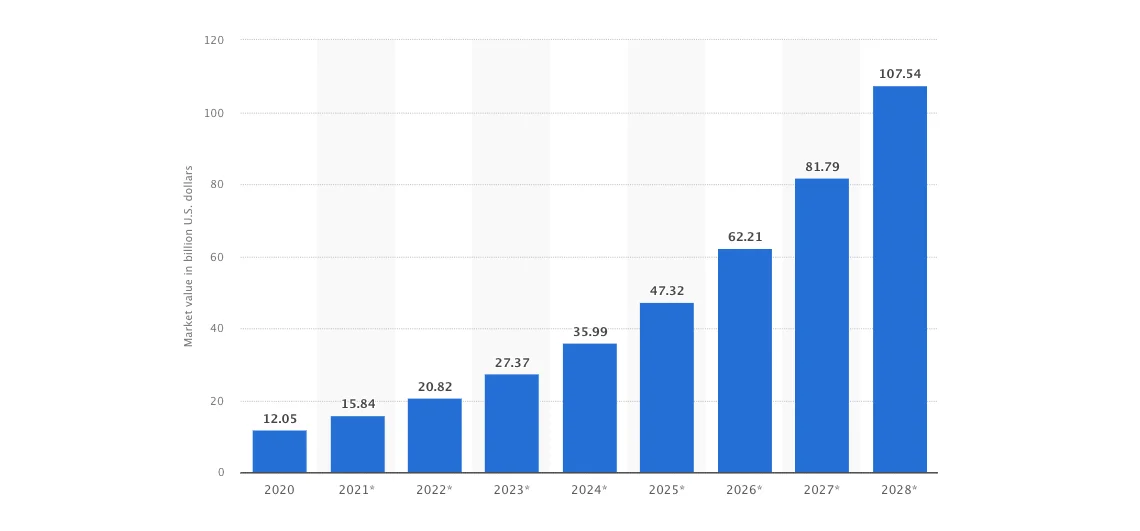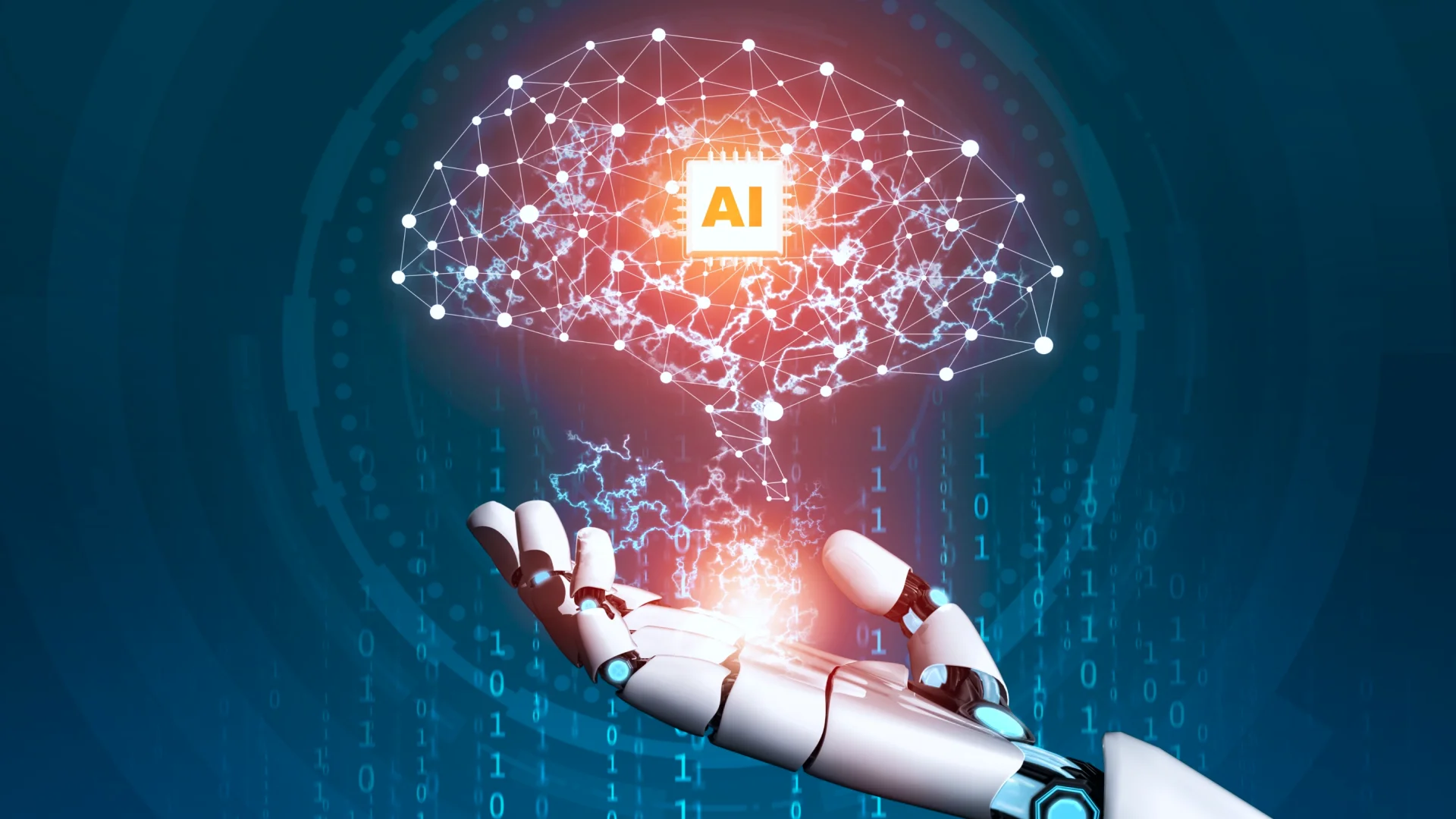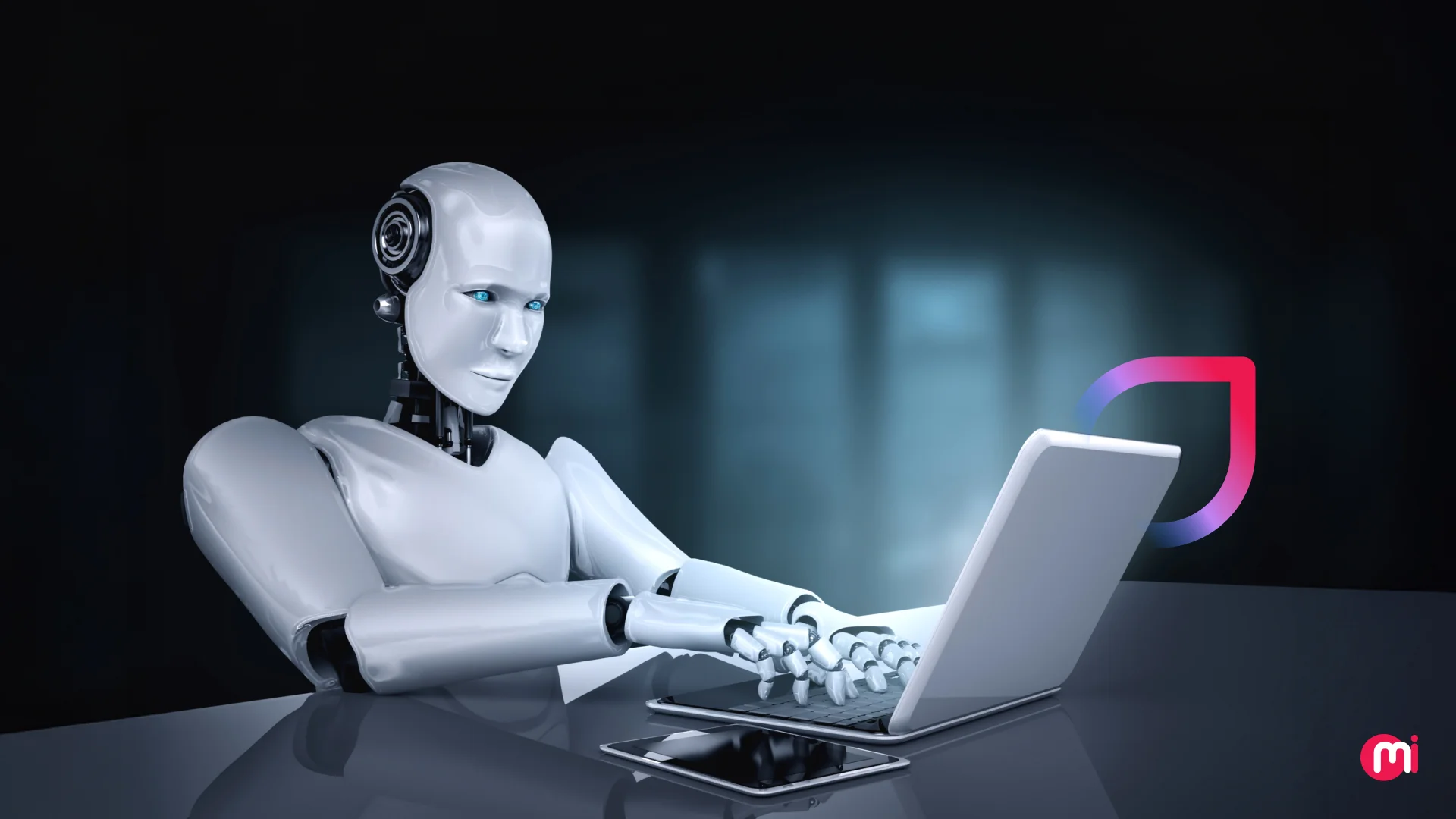How AI and ML in Business Processes are Changing the Market Landscape?
- AI/ML
- November 7, 2023
Think of a world where your favorite online or offline stores know exactly what you want to buy next and how the attire will look on you. Where customer service is available 24/7 and daily task management becomes effortless. Sounds like a daydream, right? Well, it has become a reality after the implementation of ML and AI in business processes.
Both technologies are changing the way we operate the business with their automation capabilities. AI business process optimization is helping reduce human efforts, improve productivity, lower investment costs, and generate higher revenues.
However, these advantages are just the tip of the iceberg. There is a lot more that AI and ML integrations are going to bring to our businesses. In this blog, we have explained the role of AI and ML in transforming businesses, their benefits, future trends, and emerging technologies. Read it to get an in-depth understanding of them.
What are AI and ML?
AI (Artificial Intelligence) is used for developing software or systems that can perform tasks requiring human intelligence. For example, AI can do reasoning, learning, problem-solving, understanding natural language, identifying patterns, etc. These systems stimulate human cognitive functions and automate complex processes.
They possess the capability to work with vast and complex datasets, analyze data, and extract valuable insights. AI systems help with data-driven decision-making, identify trends, and predict future outcomes. It is the force behind chatbots, recommendation systems, and predictive maintenance.
On the other hand, ML (Machine Learning) is a subset of AI that helps develop algorithms and statistical models, enabling computers to learn and make predictions or decisions without being explicitly programmed. ML systems analyze large data sets, gather valuable insights, learn from them, and adapt their algorithms to make informed decisions or predict situations.
Role of AI and ML in Bringing Transformative Impact in Business
In the year 2021, the estimated market size for artificial intelligence (AI) in marketing stood at 15.84 billion U.S. dollars. According to the Statista reports, it is anticipated that this value will surpass 107.5 billion by the year 2028.

On the other hand, the worldwide market for Machine Learning (ML) reached a value of $19.20 billion in 2022 and is projected to expand from $26.03 billion in 2023 to an impressive $225.91 billion by the year 2030, following a CAGR of 36.2%.
The impact of artificial intelligence (AI) and ML on business is quite significant. According to AI statistics, both technologies are playing a transformative role in various aspects of business, leading to remarkable reforms:
Automation and Optimization
AI and ML identify repetitive, time-consuming, and labor-intensive tasks and automate them to simplify the process. For example, AI in business handles tasks like data entry, document analysis, processing and screening, basic customer inquiries, etc.
Moreover, these systems have been designed to handle large volumes of data efficiently. They can process structured and unstructured data collected from various sources, including documents, databases, internet, email, website, etc. Natural language processing and computer vision technologies extract meaning from textual and visual data.
After receiving adequate training, AI systems automatically execute tasks using the memorized patterns. It validates data, categorises expenses, processes incoming invoices, and makes decisions according to predefined rules.
Eliminating Traditional Recruitment Processes and Challenges
With the support of AI and ML algorithms, recruiters can automate the initial stages of employee hiring and onboarding. These algorithms screen and analyze candidate resumes and receive applications for the job post.
They compare and select candidates based on skills, qualifications, and experience required to fill the job vacancy. The process saves time for human recruiters and eliminates repetitive tasks, ensuring accurate and effective screening of candidates.
AI-powered chatbots hand hold recruiters in scheduling interviews, handling candidate inquiries, and providing information about job openings. They also guide candidates through the application process, improving the overall candidate experience and reducing the burden of the HR team.
Supply Chain Optimization
AI systems study previous sales data and analyze market trends to predict future demands for targeted products. These predictions help manage inventory and reduce overstocking and stockout risks. Moreover, AI systems automatically adjust inventory levels based on real-time demand, lead times, and other variables.
AI systems optimize stock levels, reduce carrying costs, and improve cash flow. ML algorithms identify the most efficient routes for transportation and logistics. It monitors many aspects, such as weather, traffic conditions, and delivery deadlines, and chooses the best route, improving delivery experience and reducing time and transportation costs.
AI in business processes also helps with supplier selection and management, warehouse automation, quality control, personalized delivery, collaborative forecasting, cost reduction, risk management, etc.
Predictive Analytics and Decision Making
Business process AI and ML algorithms collect and integrate required data from multiple sources, such as external data sets, the internet, databases, and IoT devices. These systems clean, process, consolidate, and transform the data to make real-time predictions. It also monitors new data whenever the data becomes available and gives recommendations to users, vendors, and owners.
Fraud Detection and Risk Management
AI in business processes recognizes and stops fraudulent activities and helps manage involved risks efficiently. It is the best advantage for industries like e-commerce, insurance, finance, cybersecurity, etc. AI systems keep an eye on transaction records, historical fraud cases, user activity logs, and other related information.
They process data, learn from the analysis, and assess the likelihood of fraud for each one. If the model suspects unusual behavior, it gives alerts or takes automated actions to block the initiated transaction. AI and ML also take note of current market conditions to predict potential risks.
Machine learning models ensure compliance with industry regulations, simulate various risk scenarios, flag potential violations, and help organizations understand the impact of different risks on their business operations and financial health. Business process AI suggests risk mitigation techniques and contingency plans to prepare the organization to handle unexpected events.
Personalized Recommendations
Companies collect data notifying user preferences, demographics, behaviors, and other related information. ML systems categorize this data into segments, keeping people with similar attributes together. Using these segments, AI makes personalized recommendations and suggests products, content, and services to individual customers.
Advantages of Using AI and ML in Business Process Management
Successful integration of AI in business process management helps organizations gain a competitive advantage over other competitors. It also offers many other benefits, such as:
Enhanced Productivity
Integration of AI and ML in business process optimization increases efficiency, reduces risks of human errors and executes repetitive and mundane tasks without manual intervention.
Improved Decision Making
ML algorithms gather valuable insights from large data to support data-driven decision-making. They also assist organizations and developers in resource allotment and strategic planning.
Cost Reduction
The use of AI in business process optimization reduces operational costs and maximizes resource utilization. It can help acknowledge cost-saving opportunities and finish many tasks with minimal resources and tools.
Time-Saving
Organizations can accelerate the work using AI and ML in business processes, assist customers quickly, and resolve their queries on time.
Dedicated Assistance
AI-powered chatbots and virtual assistants help users 24/7, offering dedicated support and resolving issues promptly. These systems not only provide solutions but improve customer engagement as well.
Monitoring and Compliance
Organizations can automate repetitive tasks related to auditing, reporting and data security using AI in business process optimization. It can help companies monitor and ensure compliance with industry regulations and keep up with data security measures.
Uptight Security
Machine learning algorithms detect and respond to security threats early, protecting applications, systems, user data, and other information against vulnerabilities and cyberattacks.
Training and Education
AI-driven learning systems are able to conduct personalized training programs for employees, helping them acquire new skills and stay updated with recent technological advancements. You can even use AI when collaborating with training video companies to streamline the process and easily train your employees.
Resource Allocation
ML can handhold companies in resource distribution, like assigning human resources or machinery to specific tasks in the most efficacious way.
Broad Reach
AI and ML tools store customer data and analyze the required information to prepare material and strategies for marketing campaigns, targetting better conversion rates and a wide user base.

The Future of AI and ML in Business
Emerging AI/ML technologies that are shaping business landscape and market dynamics are as follows:
Hyper Automation
Hyper automation is a cutting-edge approach to improving business processes using the combined applications of AI and ML. It leverages both technologies to automate, optimize, and streamline a wide range of operations within an organization.
These new algorithms are far smarter than existing ones. They use auto-generated learned algorithms and trained robotics to automate complex tasks and perform them with more accuracy and speed. As per the research, the updated algorithms and hyper-automation technologies of AI and ML may minimize operational costs by 30%.
This hyper-automation can be easily scaled up or down to accommodate fluctuations in workload, ensuring businesses can respond to changing demands without hiring or laying off workforce extensively.
Multi-Task Models
Multi-task models are advanced machine learning and AL models that can execute and handle multiple tasks or objectives simultaneously using a single system. These models can learn and generalize various tasks at the same time with less training and resources. The system eliminates the need for separate and specialized models for each task, saving time and effort.
They also improve data utilization and reduce redundancy by using shared data across different tasks. In simple words, the data gathered to perform one task can help execute other tasks as well. Along with it, these models can be fine-tuned and customized to cater to specific requirements of businesses and industries.
Natural Language Processing
Natural Language Processing (NLP) is a subset of artificial intelligence and machine learning that establishes connections and facilitates interaction between computers and human language. It empowers computers to comprehend, interpret, and generate meaningful and contextually relevant human language.
NLP is the technology behind AI chatbots and virtual assistants that answer customer queries and resolve issues. It stays active 24/7, providing optimal customer support. Additionally, NLP automatically extracts useful data insights and reliable information from unstructured text data, including emails, collected data, customer feedback, social media conversations, etc.
It analyzes the data to generate meaningful responses and execute other tasks. NLP can automate routine administrative tasks like data entry, lengthy document summarization, and content categorization. It can enhance the productivity and accuracy of internal search engines and content retrieval systems, helping employees and users find the information they are looking for.
AI-Based Cybersecurity Systems
These are hi-tech security systems, ensuring uptight and advanced security for implemented AI in business processes. They protect computer systems, networks, and sensitive data from cyber threats and attacks. They leverage algorithms to monitor, identify, and respond to security threats immediately.
It also reduces false alarms and unrequired security alerts, stopping them from taking time unnecessarily and freeing them to focus on legitimate threats. Business process AI security systems automate routine security tasks, like vulnerability assessment, patch management, and network monitoring, helping security personnel identify threats on time.
AI-Enabled Conceptual Design
This technology assists developers during product design, architecture, and other creative endeavors. The system automates many stages of the design process, generates new ideas, and facilitates the exploration of innovative concepts.
AI systems can suggest novel ideas and concepts, produce multiple design iterations, refine and validate design decisions, and help designers and architects generate a wide range of designs within a short span.
The technology minimizes the product design cost associated with manual labor and CAD (Computer-Aided Design) drawings or architectural blueprints. It also takes references from previous design projects, incorporating lessons and best practices into new design concepts.
No-Code Low-Code Innovations
Low-code and no-code platforms allow developers with limited experience to create apps and automate processes using visual interfaces and pre-built components. When AI is incorporated into these platforms, it enhances the capabilities of these platforms.
The technical integration supports rapid development, reducing the time required to build and deploy apps. Using these platforms, industries, organizations, or individuals can create applications without relying on IT departments.
The integration of this AI in business processes further empowers these developers to automate complex procedures. Also, it can automate and optimize complicated workflows, encouraging innovation, faster task execution, and better resource utilization.
What are the Challenges in Integrating AI & ML in Business?
Integrating Artificial Intelligence and Machine Learning into business operations can be challenging due to several factors. Some of the key challenges include:
Lack of Advanced Computing
AI is in the development stage, yet it utilizes processing power in a large quantity, and not all organizations have access to this much processing power. In the current era, if a company wants to implement AI in business processes, then it may have to invest heavily in building a strong cloud infrastructure and parallel processing systems. Even in this scenario, if data volumes go above the limit, these systems cannot help much.
Hiring Skilled Professionals
AI and ML are emerging technologies that are new to people, organizations, and developers. Hence, finding, hiring, and retaining expert data scientists, ML experts, AI experts may be challenging. The demand for these professionals is high, but the market is yet to meet it. However, MindInventory can be your destination to find skilled AI/ML developers.
Less Availability of Data for Training
Artificial intelligence and machine learning require high-quality and large amounts of labeled data for training. Moreover, developers have to ensure that the collected data is clean, sufficient, and relevant to the product type and industry. The availability of this data is less, and the cleaning process is also a significant challenge. To avoid this situation, you can hire reliable companies like MindInventory for synthetic data modelling.
Integration with Existing Systems
Legacy systems are less compatible with AI/ML software and products. Therefore, organizations have to pay a higher amount to integrate them with these systems. Despite the investment, AI/ML models are complex and difficult to interpret. They may hinder trust and decision-making.
Compliance, Data Privacy, and Security Issues
AI systems must adhere to ethical standards and comply with regulations, which makes the development and deployment process more complicated. Along with it, AI systems often deal with sensitive data, which is more vulnerable to cyberattacks like hacking, data theft, phishing, etc. Ensuring its safety is a challenge for organizations.
Revolutionize Your Business Using AI & ML Algorithms with MindInventory
The integration of AI and ML in business processes is undeniably transforming the market landscape in profound ways. The evolution is moving from manual, rule-based operations to data-driven, predictive, and efficient workflows. However, it’s not without its challenges. From data quality to ethical considerations, the road to successful AI/ML integration is paved with hurdles. Businesses need help from reputed organizations to ensure successful implementation of AI and ML.
MindInventory is a prestigious organization specializing in providing AI and ML Development Services to businesses. We have a skilled team of data scientists, machine learning engineers, and AI engineers for hire who are well-versed with the latest techniques and best practices.
They use pre-built frameworks and models to accelerate the development process while focusing on core business requirements. We take a strategic approach to handle the technical aspects of AI development services.
Hire machine learning engineers skilled to effectively deal with concerns related to data privacy, security, and ethical considerations, reducing the risks associated with AI and ML implementations. We specialize in providing innovativ AI/ML development services and effective strategies to keep your business competitive.
FAQ on AI and ML
You can integrate AI and ML in business processes to identify specific areas and use cases where these technologies can bring value. Its prime benefits include automating repetitive tasks, offering predictive insights, managing involved risks, and enhancing decision-making, customer experience, and productivity.
It can be the future of business but nothing is determined yet. AI is a transformative technology that comes with advantages and challenges. We are yet to see its impact on business. Moreover, the impact will vary according to industry, company size, adoption and implementation requirements, data quality, talent acquisition, and ethical considerations.
Tools and frameworks like Scikit Learn, TensorFlow, Theano, Xgboost, MxNet, Auto ML, PyTorch, CNTK, etc., are being used in businesses currently. These frameworks help build AI software and systems for required purposes.
You can automate many processes, such as document analysis, information retrieval, customer support, employee onboarding, expense tracking, and data security using NLP algorithms. These algorithms will collect the meaning and insights from textual data and enhance the learning capacity of machines, helping them perform repetitive and time-consuming tasks.
The implementation cost largely depends on project requirements, tech stack, resource needs, programming language, project complexities, features, customization, ongoing maintenance, etc. So, you cannot predict the cost accurately before discussing the project with professionals. For accurate budget estimation, connect with the MindInventory expert team.













